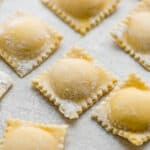
How to Make Ravioli
Homemade ravioli is a labor of love but once you get the hang of it, it's a lot of fun... and delicious!
Servings 50 ravioli (or so)
Calories 73kcal
Equipment
Ingredients
Full Batch
- 4 cup all purpose flour
- 1 teaspoon kosher salt
- 5 large eggs
- 3 large egg yolks
For half the recipe:
- 2 cups all purpose flour
- 1/2 teaspoon kosher salt
- 3 large eggs
- 2 large egg yolks
Instructions
- To make the ravioli dough, mix the flour and salt together on a clean work surface. Form into a 10-12 inch diameter mound.
- Using your hands, make a well in the flour and salt mixture. Pour the eggs and egg yolks into the well. Using a fork, gently beat the eggs and yolks. Once you’ve done that, slowly incorporate the flour into the eggs.
- If the dough is too wet and it’s sticking to your work surface, add a little bit of flour to the dough. If the dough is too dry, add a spritz of water to the dough.
- Form the dough into a ball. Begin kneading it for 10 minutes. (Pushing the dough with the heel of your hand, and then rotating it). You’ll know the dough is ready when you press into it and it springs back. The dough should have a nice smooth appearance to it.
- Wrap the dough with plastic wrap and let it sit for 30 minutes at room temp. (If you aren’t using the dough right away, place it in the refrigerator).
- Roll out the ravioli (I use my kitchen aid pasta roller attachment). Roll out to about 1/8” to 1/16" thick. (Depending on how thin/thick you want your pasta to be).
- Using a ravioli mold, place the sheet of dough over the ravioli mold (following instructions for the ravioli mold), gently create a small divot in the dough. Fill each cube with 1 tablespoon of filling. Cover with dough. Use a rolling pin and roll overtop the dough so that it seals. Turn the mold over and tap it on the counter to release the ravioli. Use a knife to separate any ravioli that didn’t separate.
- Transfer the ravioli to a baking sheet lined with parchment paper that has been dusted with flour. Continue rolling out the pasta dough and filling the ravioli until all of the dough and filling has been used.
Cooking the Ravioli
- Bring pot of water to boil. Once boiling add 1 tablespoon of salt to the water. Add some of the ravioli to the water. Don’t overcrowd. You’ll want to do this in batches. Cook for 3-4 minutes or until they float to the top. Using a slotted spoon, transfer them to a lightly oiled plate or add them to whatever sauce you plan on serving with them.
Notes
I highly recommend you go through and read the blog post associated with this recipe before making the ravioli. I go into a lot of detail (accompanied by photos) about how to successfully make ravioli.
Here are additional tips:
Tools for Making Homemade Ravioli
- Ravioli maker (this is what I have and use) There are different methods people use for stuffing and making the ravioli. I use a ravioli maker. You can also use a hand stamp ravioli or feel free to free-hand it by cutting your own squares and then cinch the edges together using the tines of a fork.
- Ravioli press: You can do square or circular ravioli
- Ravioli roller
- Pasta sheet attachment
Nutrition
Calories: 73kcal | Carbohydrates: 12g | Protein: 3g | Fat: 1g | Saturated Fat: 1g | Cholesterol: 52mg | Sodium: 84mg | Potassium: 30mg | Fiber: 1g | Sugar: 1g | Vitamin A: 74IU | Calcium: 10mg | Iron: 1mg